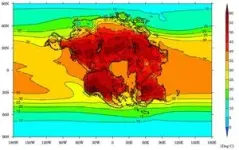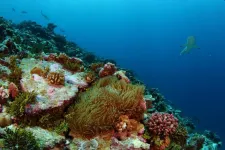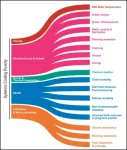(Press-News.org) A new study shows unprecedented heat is likely to lead to the next mass extinction since the dinosaurs died out, eliminating nearly all mammals in some 250 million years time.
The research, published today in Nature Geoscience and led by the University of Bristol, presents the first-ever supercomputer climate models of the distant future and demonstrates how climate extremes will dramatically intensify when the world’s continents eventually merge to form one hot, dry and largely uninhabitable supercontinent.
The findings project how these high temperatures are set to further increase, as the sun becomes brighter, emitting more energy and warming the Earth. Tectonic processes, occurring in the Earth’s crust and resulting in supercontinent formation would also lead to more frequent volcanic eruptions which produce huge releases of carbon dioxide into the atmosphere, further warming the planet.
Mammals, including humans, have survived historically thanks to their ability to adjust to weather extremes, especially through adaptations such as fur and hibernating in the cold, as well as short spells of warm weather hibernation.
While mammals have evolved to lower their cold temperature survivable limit, their upper temperature tolerance has generally remained constant. This makes exposure to prolonged excessive heat much harder to overcome and the climate simulations, if realised, would ultimately prove unsurvivable.
Lead author Dr Alexander Farnsworth, Senior Research Associate at the University of Bristol, said: “The newly-emerged supercontinent would effectively create a triple whammy, comprising the continentality effect, hotter sun and more CO2 in the atmosphere, of increasing heat for much of the planet. The result is a mostly hostile environment devoid of food and water sources for mammals.
“Widespread temperatures of between 40 to 50 degrees Celsius, and even greater daily extremes, compounded by high levels of humidity would ultimately seal our fate. Humans – along with many other species – would expire due to their inability to shed this heat through sweat, cooling their bodies.”
Although human-induced climate change and global warming is likely to be a growing cause of heat stress and mortality in some regions, research suggests the planet should largely remain habitable until this seismic landmass change in the deep future. But when the supercontinent forms, findings indicate only somewhere between 8% and 16% of land would be habitable for mammals.
Co-author Dr Eunice Lo, Research Fellow in Climate Change and Health at the University of Bristol said: “It is vitally important not to lose sight of our current Climate Crisis, which is a result of human emissions of greenhouse gases. While we are predicting an uninhabitable planet in 250 million years, today we are already experiencing extreme heat that is detrimental to human health. This is why it is crucial to reach net-zero emissions as soon as possible.”
The international team of scientists applied climate models, simulating temperature, wind, rain, and humidity trends for the next supercontinent – called Pangea Ultima – expected to form in the next 250 million years. To estimate the future level of CO2 the team used models of tectonic plate movement, ocean chemistry and biology to map out inputs and outputs of CO2.
The future CO2 calculations were led by Professor Benjamin Mills at the University of Leeds, who said: “We think CO2 could rise from around 400 parts per million (ppm) today to more than 600 ppm many millions of years in the future. Of course, this assumes that humans will stop burning fossil fuels, otherwise we will see those numbers much, much sooner.”
Dr Farnsworth, also a visiting Professor at the Tibetan Plateau Earth System, Environment and Resources (TPESER), at the Chinese Academy of Sciences Institute of Tibetan Plateau Research said: “The outlook in the distant future appears very bleak. Carbon dioxide levels could be double current levels. With the Sun also anticipated to emit about 2.5% more radiation and the supercontinent being located primarily in the hot, humid tropics, much of the planet could be facing temperatures of between 40 to 70 °C.
“This work also highlights that a world within the so-called ‘habitable zone’ of a solar system may not be the most hospitable for humans depending on whether the continents are dispersed, as we have today, or in one large supercontinent.”
In addition, the research illustrates the importance of tectonics and continental layouts when conducting research into planets beyond our solar system, called exoplanets. Although the Earth will still be within the habitable zone in 250 million years’ time, for mammals the formation of a supercontinent with elevated carbon dioxide will make most of the world uninhabitable. The findings suggest the landmass layout for a distant world could be a key factor when determining how liveable it is for humans.
The research formed part of a funded project, funded by the UK Research and Innovation Natural Environment Research Council (UKRI NERC) looking at the climates of supercontinents and mass extinctions.
Paper
‘Climate extremes likely to drive land mammal extinction during next supercontinent assembly’ by Alexander Farnsworth et al. in Nature Geoscience
END
New research reveals extreme heat likely to wipe out humans and mammals in the distant future
2023-09-25
ELSE PRESS RELEASES FROM THIS DATE:
Theories about the natural world may need to change to reflect human impact
2023-09-25
New research, reported in Nature Ecology & Evolution, (25 September 2023) has for the first time validated at scale, one of the theories that has underpinned ecology for over half a century. In doing so, the findings raise further questions about whether models should be revised to capture human impacts on natural systems.
Scientists working in the 50’s and 60’s developed theories to predict the ecological distribution of species. These theories could be applied across a broad range of environments and variables such as food supply or temperature and when tested on a small scale they were found to be accurate. Amongst the earliest examples of these ...
Ocean acidification research is robust despite ebbs and flows
2023-09-25
A new objective examination of almost a quarter-of-a-century of ocean acidification research shows that, despite challenges, experts in the field can have confidence in their research.
The University of Adelaide’s Professor Sean Connell from the Ecology and Evolutionary Biology unit led the study.
“In our field, the marine science community was galvanised by the demonstration of how ocean acidification impairs shell-building life, which has profound implications for life on the planet,” ...
Systemic cooling poverty: A new facet of deprivation emerging in a warming planet
2023-09-25
OXFORD - 25/09/2023 - A new study in Nature Sustainability - published today by researchers from Oxford University, Ca’ Foscari University of Venice, the Euro-Mediterranean Center on Climate Change, the European Institute on Economics and the Environment and the London School of Hygiene & Tropical Medicine - brings attention to a new relevant dimension of deprivation which is clearly emerging in a warming world: cooling poverty. The study highlights the multidimensional nature of cooling poverty and introduces the new concept of systemic cooling ...
PSU study examines how weather patterns will change in the future
2023-09-25
In a warming Pacific Northwest, summers are getting hotter and winters less cold, but the atmospheric patterns that influence the weather aren’t necessarily expected to become stronger or more frequent by the end of the century, according to a new Portland State University study.
That means that in an overall warmer climate, models suggest we'll have the same variety of atmospheric patterns as we have now but the weather we experience from them will be warmer and, in some cases, wetter.
Graham Taylor, a Ph.D. student in PSU’s ...
Drug discovery on an unprecedented scale
2023-09-25
Boosting virtual screening with machine learning allowed for a 10-fold time reduction in the processing of 1.56 billion drug-like molecules. Researchers from the University of Eastern Finland teamed up with industry and supercomputers to carry out one of the world’s largest virtual drug screens.
In their efforts to find novel drug molecules, researchers often rely on fast computer-aided screening of large compound libraries to identify agents that can block a drug target. Such a target can, for instance, be an enzyme that enables a bacterium to withstand ...
Specially appointed Professor Katsumi Ida to receive the Chandrasekhar Award
2023-09-25
Research is being conducted around the world to confine high-temperature plasma in a magnetic field to realize nuclear fusion power generation. The most important issue is maintaining stable high-temperature plasma for a long time, which involves many challenges. The plasma confined by a magnetic field has a temperature gradient from the low-temperature periphery to the high-temperature center, where the fusion reaction takes place, with the temperature at the center being over 100 million degrees Celsius and that at the periphery being several hundred ...
How can the use of plastics in agriculture become more sustainable?
2023-09-25
It is impossible to imagine modern agriculture without plastics. 12 million tonnes are used every year. But what about the consequences for the environment? An international team of authors led by Thilo Hofmann from the Division of Environmental Geosciences at the University of Vienna addresses this question in a recent study in Nature Communication Earth and Environment. The research shows the benefits and risks of using plastics in agriculture, and identifies solutions that ensure their sustainable use.
Once celebrated as a symbol of ...
Two-of-a-kind strike oil
2023-09-25
Kyoto, Japan -- Not all yeasts are created equally. Unlike the yeast used by bakers and beer brewers for converting sugars to carbon dioxide and fermentation, oleaginous yeasts convert sugars from inedible biomass into fats and oils.
A research group jointly led by Kyoto University and Ryukoku University has discovered two new species of oil-forming yeast in the soil of Shiga Prefecture. Their study also examines the relationship between the prefecture's diverse climate and microbial ecology.
"We are gauging the potential benefits of applying oleaginous yeast to sustainable oil and fat production through isolation technology, particularly in reducing ...
SwRI, UTSA collaborate to measure the felt heat on San Antonio’s West Side
2023-09-25
SAN ANTONIO — Sept. 25, 2023 —Southwest Research Institute and The University of Texas at San Antonio (UTSA) are collaborating to study the “felt heat” of San Antonio’s historic West Side. The prevalence of paved surfaces creates an environment that feels considerably hotter than the rest of the city.
The work, led by Principal Scientist Dr. Stuart Stothoff of SwRI’s Chemistry and Chemical Engineering Division and Dr. Esteban Lopez Ochoa of the Margie and Bill Klesse College of ...
Rivers contain hidden sinks and sources of microplastics
2023-09-25
Significant quantities of microplastic particles are being trapped in riverbed sediments or carried through the air along major river systems, a new study has shown.
The research, conducted along the length of the Ganges River in South Asia, found on average about 41 microplastic particles per square metre per day settled from the atmosphere. .
In addition, analysis by scientists found 57 particles per kilogram on average in sediment from the riverbed as well as one particle in every 20 litres of ...









